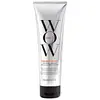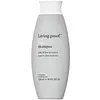What's inside
What's inside
 Key Ingredients
Key Ingredients

 Benefits
Benefits

 Concerns
Concerns

 Ingredients Side-by-side
Ingredients Side-by-side

Water
Skin ConditioningSodium Methyl 2-Sulfolaurate
CleansingCocamidopropyl Hydroxysultaine
CleansingSodium Cocoyl Isethionate
CleansingSodium Lauryl Sulfoacetate
CleansingSodium Lauroamphoacetate
CleansingSodium Methyl Cocoyl Taurate
CleansingGlycerin
HumectantPhenoxyethanol
PreservativeDisodium 2-Sulfolaurate
CleansingParfum
MaskingSodium Cocoyl Glycinate
CleansingSodium PCA
HumectantPEG-150 Distearate
EmulsifyingPropylene Glycol
HumectantPolyquaternium-22
Chlorphenesin
AntimicrobialPPG-2 Hydroxyethyl Cocamide
EmulsifyingBenzoic Acid
MaskingDisodium EDTA
Dehydroacetic Acid
PreservativeCitric Acid
BufferingHydrolyzed Wheat Starch
Skin ConditioningHydrolyzed Wheat Protein
Skin ConditioningHydrolyzed Keratin
HumectantPotassium Benzoate
PreservativeButylene Glycol
HumectantTocopheryl Acetate
AntioxidantPotassium Sorbate
PreservativeBHA
AntioxidantCitronellol
PerfumingLinalool
PerfumingHexyl Cinnamal
PerfumingWater, Sodium Methyl 2-Sulfolaurate, Cocamidopropyl Hydroxysultaine, Sodium Cocoyl Isethionate, Sodium Lauryl Sulfoacetate, Sodium Lauroamphoacetate, Sodium Methyl Cocoyl Taurate, Glycerin, Phenoxyethanol, Disodium 2-Sulfolaurate, Parfum, Sodium Cocoyl Glycinate, Sodium PCA, PEG-150 Distearate, Propylene Glycol, Polyquaternium-22, Chlorphenesin, PPG-2 Hydroxyethyl Cocamide, Benzoic Acid, Disodium EDTA, Dehydroacetic Acid, Citric Acid, Hydrolyzed Wheat Starch, Hydrolyzed Wheat Protein, Hydrolyzed Keratin, Potassium Benzoate, Butylene Glycol, Tocopheryl Acetate, Potassium Sorbate, BHA, Citronellol, Linalool, Hexyl Cinnamal
Water
Skin ConditioningSodium Methyl Cocoyl Taurate
CleansingCocamidopropyl Hydroxysultaine
CleansingDecyl Glucoside
CleansingSodium Lauroyl Lactylate
EmulsifyingSodium Cocoyl Glycinate
CleansingMaltooligosyl Glucoside
Skin ConditioningLinoleamidopropyl Pg-Dimonium Chloride Phosphate
Amaranthus Caudatus Seed Extract
Skin ConditioningSodium Cocoyl Isethionate
CleansingCeteareth-60 Myristyl Glycol
EmulsifyingCassia Hydroxypropyltrimonium Chloride
Hydrogenated Starch Hydrolysate
HumectantFurcellaria Lumbricalis Extract
Skin ConditioningPolyquaternium-47
Skin ConditioningPhytantriol
HumectantHydroxyacetophenone
AntioxidantPPG-2 Hydroxyethyl Cocamide
EmulsifyingPEG-150 Pentaerythrityl Tetrastearate
EmulsifyingTrisodium Ethylenediamine Disuccinate
Sodium Benzoate
MaskingCitric Acid
BufferingParfum
MaskingLinalool
PerfumingHexyl Cinnamal
PerfumingCitronellol
PerfumingLimonene
PerfumingWater, Sodium Methyl Cocoyl Taurate, Cocamidopropyl Hydroxysultaine, Decyl Glucoside, Sodium Lauroyl Lactylate, Sodium Cocoyl Glycinate, Maltooligosyl Glucoside, Linoleamidopropyl Pg-Dimonium Chloride Phosphate, Amaranthus Caudatus Seed Extract, Sodium Cocoyl Isethionate, Ceteareth-60 Myristyl Glycol, Cassia Hydroxypropyltrimonium Chloride, Hydrogenated Starch Hydrolysate, Furcellaria Lumbricalis Extract, Polyquaternium-47, Phytantriol, Hydroxyacetophenone, PPG-2 Hydroxyethyl Cocamide, PEG-150 Pentaerythrityl Tetrastearate, Trisodium Ethylenediamine Disuccinate, Sodium Benzoate, Citric Acid, Parfum, Linalool, Hexyl Cinnamal, Citronellol, Limonene
 Reviews
Reviews

Ingredients Explained
These ingredients are found in both products.
Ingredients higher up in an ingredient list are typically present in a larger amount.
Citric Acid is an alpha hydroxy acid (AHA) naturally found in citrus fruits like oranges, lemons, and limes.
Like other AHAs, citric acid can exfoliate skin by breaking down the bonds that hold dead skin cells together. This helps reveal smoother and brighter skin underneath.
However, this exfoliating effect only happens at high concentrations (20%) which can be hard to find in cosmetic products.
Due to this, citric acid is usually included in small amounts as a pH adjuster. This helps keep products slightly more acidic and compatible with skin's natural pH.
In skincare formulas, citric acid can:
While it can provide some skin benefits, research shows lactic acid and glycolic acid are generally more effective and less irritating exfoliants.
Most citric acid used in skincare today is made by fermenting sugars (usually from molasses). This synthetic version is identical to the natural citrus form but easier to stabilize and use in formulations.
Read more about some other popular AHA's here:
Learn more about Citric AcidCitronellol is used to add fragrance/parfum to a product. It is often derived from plants such as roses. In fact, it can be found in many essential oils including geranium, lavender, neroli, and more. The scent of Citronellol is often described as "fresh, grassy, and citrus-like".
Since the Citronellol molecule is already unstable, Citronellol becomes irritating on the skin when exposed to air.
Citronellol is a modified terpene. Terpenes are unsaturated hydrocarbons found in plants. They make up the primary part of essential oils.
Citronellol is not able to be absorbed into deeper layers of the skin. It has low permeability,
Citronellol is also a natural insect repellent.
Learn more about CitronellolCocamidopropyl Hydroxysultaine is a synthetic cleansing agent, though it is derived from coconut oil.
It is used to enhance the texture of products by boosting lather and thickening the texture. As a cleanser, Cocamidopropyl Hydroxysultaine is mild.
Hexyl Cinnamal is a fragrance ingredient with a similar scent to jasmine. It can be naturally found in chamomile essential oil.
This ingredient is a known EU allergen and may sensitize the skin. The EU requires this ingredient to be listed separately on an ingredients list.
Hexyl Cinnamal is not water soluble but is soluble in oils.
Learn more about Hexyl CinnamalLinalool is a fragrance and helps add scent to products. It's derived from common plants such as cinnamon, mint, citrus, and lavender.
Like Limonene, this ingredient oxidizes when exposed to air. Oxidized linalool can cause allergies and skin sensitivity.
This ingredient has a scent that is floral, spicy tropical, and citrus-like.
Learn more about LinaloolParfum is a catch-all term for an ingredient or more that is used to give a scent to products.
Also called "fragrance", this ingredient can be a blend of hundreds of chemicals or plant oils. This means every product with "fragrance" or "parfum" in the ingredients list is a different mixture.
For instance, Habanolide is a proprietary trade name for a specific aroma chemical. When used as a fragrance ingredient in cosmetics, most aroma chemicals fall under the broad labeling category of “FRAGRANCE” or “PARFUM” according to EU and US regulations.
The term 'parfum' or 'fragrance' is not regulated in many countries. In many cases, it is up to the brand to define this term.
For instance, many brands choose to label themselves as "fragrance-free" because they are not using synthetic fragrances. However, their products may still contain ingredients such as essential oils that are considered a fragrance by INCI standards.
One example is Calendula flower extract. Calendula is an essential oil that still imparts a scent or 'fragrance'.
Depending on the blend, the ingredients in the mixture can cause allergies and sensitivities on the skin. Some ingredients that are known EU allergens include linalool and citronellol.
Parfum can also be used to mask or cover an unpleasant scent.
The bottom line is: not all fragrances/parfum/ingredients are created equally. If you are worried about fragrances, we recommend taking a closer look at an ingredient. And of course, we always recommend speaking with a professional.
Learn more about ParfumWe don't have a description for PPG-2 Hydroxyethyl Cocamide yet.
Sodium Cocoyl Glycinate is a cleansing agent. It can be naturally derived or synthetically-created.
As a surfactant, it helps clean your skin by gathering dirt, oil, and other pollutants to be rinsed away more easily.
Sodium cocoyl isethionate is a natural ingredient from coconut oil. It is an ultra gentle cleanser that gives a nice foam without drying the skin or impacting the skin barrier.
The amount of foam created depends on the amount of sodium cocoyl isethionate used in the product.
This ingredient also helps improve the spreadability of a product.
Learn more about Sodium Cocoyl IsethionateThis gentle cleansing and foaming ingredient is known for leaving a smooth feeling in skin and hair. It is made using coconut oil.
According to the manufacturer, it is soluble in water and has resistance to hard water, acid, and alkali.
Due to its coconut base, it may not be Malassezia folliculitis safe.
Learn more about Sodium Methyl Cocoyl TaurateWater. It's the most common cosmetic ingredient of all. You'll usually see it at the top of ingredient lists, meaning that it makes up the largest part of the product.
So why is it so popular? Water most often acts as a solvent - this means that it helps dissolve other ingredients into the formulation.
You'll also recognize water as that liquid we all need to stay alive. If you see this, drink a glass of water. Stay hydrated!
Learn more about Water